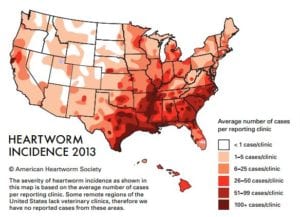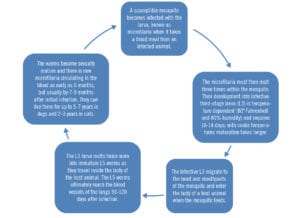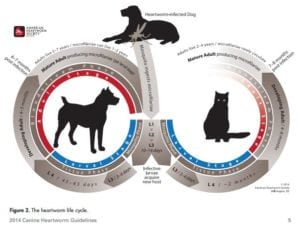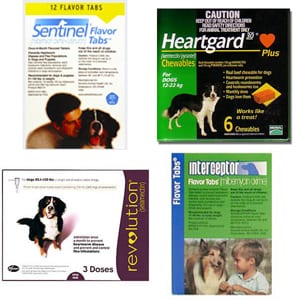By: Kacie Schmitt, DVM, Diplomate, ACVIM (Cardiology)
What is heartworm disease?
Heartworm disease, caused by the heartworm Dirofilaria immitis, has been diagnosed around the globe, including the lower 48 states and Hawaii.
Domestic and wild dogs are the normal hosts for heartworms. Although less likely to develop a heartworm infection, cats and ferrets can harbor infections as well.
The life cycle of the heartworm is 7-9 months:
When is the transmission season?
The peak months for heartworm transmission in the Northern Hemisphere are typically July and August. However, urban sprawl has led to the formation of “heat islands,” as buildings and parking lots retain heat during the day creating microenvironments with the potential to support the development of heartworm larvae in mosquitos during colder months, thereby lengthening the transmission season, potentially enabling year-round transmission.
How do I know if my pet has heartworm disease?
Your primary care veterinarian will perform a blood test looking for microfilaria and adult heartworms on a yearly basis. Because of the lower risk and incidence of infection, cats, especially indoor-only cats, may not be tested for heartworm disease on an annual basis.
Some pets with mild heartworm infections do not show any symptoms. However, the signs commonly associated with heartworm disease can include:
- Cough
- Exercise intolerance
- Changes in breathing (fast, labored)
- Syncope (fainting)
- Abnormal lung sounds on exam.
- Ascites (fluid accumulation in the abdominal cavity)
- Breaking of the red blood cells inside the blood vessels (may notice dark brown to black color urine)
How is heartworm disease prevented?
Heartworm disease is preventable despite the fact that dogs are highly susceptible to infection. Heartworm preventative medications require a prescription from a licensed veterinarian as well as a record of a recent negative heartworm test. Preventative options include:
- Oral Medications
- Topical Medications
- Injections administered every 6 months by your veterinarian.
It is recommended that puppies be started on a heartworm preventative no later than 8 weeks of age and that it is continued year-round since transmission season is throughout the year in many regions.
The class of medication used to prevent heartworm disease is called macrocyclic lactones. It includes the preventive products containing ivermectin, milbemycin oxime, moxidectin, and selamectin. These medications are highly effective and known to among the safest medications used in veterinary medicine. However, some dogs may be sensitive to certain products and your primary care veterinarian will take this into consideration when discussing options with you.
| Drug | Route of Administration | Products Available |
| Ivermectin | Oral | Heartgard (Merial)
Heartgard plus (Merial) Iverhart max (Virbac) Iverhart plus (Virbac) |
| Milbemycin oxime | Oral | Sentinel (Novartis)
Interceptor (Novartis) Trifexis (Elanco) |
| Moxidectin | Topical | Advantage multi (Bayer) |
| Selamectin | Topical | Revolution (Pfizer) |
| Moxidectin | Injection under the skin | Proheart 6 (Zoetis) |
How is Heartworm Disease treated?
If infection is caught early, timely treatment can be provided to minimize the damage to your pet’s lungs.
Cats: There is no therapy to kill the adult heartworms in cats. Many cats tolerate their infection without any noticeable symptoms, or only mild symptoms. Therapy is aimed at preventing further infection by starting a macrocyclic lactone and allowing the adult heartworms to die naturally. In some cases, the infection is so severe that surgery is required to remove the heartworms.
Dogs: Treatment is a long process (about 6 months). To kill the adult heartworm, 3 injections of a drug called melarsomine are given over 2 months. Because the injections must be given deep in the muscle, swelling and soreness at the injection site may be present for a few days, but can be managed with pain medications. To kill the larva and juvenile heartworms, a macrocyclic lactone is started. Additionally, your pet may require prednisone, a corticosteroid used to help reduce inflammation in the lungs and clinical signs associated with the infection. In some severe cases, hospitalization for stabilization of respiratory signs, other cardiac medications, or surgical removal of the worms may be needed.
During and after the treatment process, severe exercise restriction is essential to minimize a potentially life-threatening complication, known as a pulmonary thromboembolism. A pulmonary thromboembolism (PTE) is a blockage of the lung’s main artery or one of its branches. PTEs are an inevitable consequence of successful heartworm treatment because the dead worms will ultimately travel to the periphery of the lungs and lodge there. Mild PTEs often do not cause symptoms. However, severe PTEs can cause severe respiratory distress and death. For this reason, strict exercise restriction is required.
For more information about heartworm disease, please visit www.heartwormsociety.org
To learn more about CVCA Cardiac Care for Pets, visit www.cvcavets.com






Recent Comments